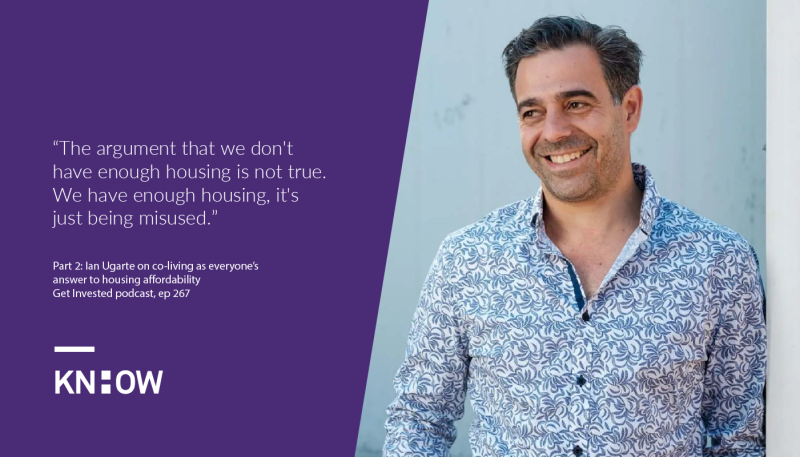Ian Ugarte says housing affordability in Australia can be solved through co-living and repurposing multi bedroom properties.
One of the biggest talking points in Australian property is the so-called ‘housing affordability crisis’, however leading property expert Ian Ugarte says there is an easy, achievable and cheap solution – the co-living model of collaborative consumption.
Ian is the leading micro-apartment, rooming house, and boarding house specialist from the Australian Housing Initiative and Invida Co-living.
On Property Hub’s Get Invested podcast, he joined KnowHow founder Bushy Martin to provide insight on how investors, tenants and the wider Australian community can embrace the idea of co-living.
How housing is being misused in Australia
Ian presented findings from his research which suggest that a big part of the housing affordability issue and rental crisis stems from Australians living in properties not designed for their household.
“The argument that we don’t have enough housing is not true. We have enough housing, it’s just being misused. So if we can take the existing housing stock, or purpose build when we want to build new, and make it adaptable, we’re ok,” Ian said.
“The census data from 2011 to 2016 was what we had at the time, and we found that there’s 12 million empty bedrooms every night in Australia because people build four bedroom, two bathroom homes and only 2.38 people live in it. So if you’ve got the parents in one room and a child in another, that means that there’s two empty bedrooms, which is either an office and the other one which is full of stuff you can’t fit in the garage. And so between 2016 and 2021, 82% of all new housing that was built or brought to the market was four or five bedroom houses, and 69.5% of the new households were singles and couples.
“So we’re seeing a growing trend that the new housing being built is not fit for purpose for what the people need it for. And we’ve got this affordability issue because the outcome is when a single or a couple goes out looking for a rental, the only choice they have is a four bedroom house. If you gave them more choices, they will take it.”
How co-living is a win-win situation
Changing the usage of these empty bedrooms can make a huge change to the marketplace, for both tenants and investors.
“When we’re taking existing housing stock which is under-utilised, we’re not adding to the exercise and it’s not expensive thing to create and it’s not having an environmental impact,” Bushy said.
“We’re suddenly diversifying the income streams for investors, so that instead of getting $500 for a four bedroom property, there’s substantially more and you’re not reliant on one tenant. You’ve effectively got three or four tenants in the same place and at the same time.
“And from a tenant perspective, all of a sudden you’ve got an affordable exercise that gives you the accommodation you need at a fraction of the cost and positions them potentially then to be able to save, to put together to to do their own home at a later point in time. So it’s just a beautiful solution.”
Why investors should shift from short-term accomodation to co-living
Ian said investors can gain more from properties being repurposed for co-living, as opposed to renting them out as Airbnbs.
“Some people don’t believe that the demands there for co-living. Well, I’m sure the hotel industry didn’t think that there was a demand for people to rent out parts of their home and short stays via Airbnb mostly, who then took that market and damaged the rest of the market. So I’ll tell you this – in the top 20 most unaffordable cities every year, Australia has had 13 or 14 cities every year for the last ten years,” he said.
“At one point in time, Hobart was the second most unaffordable city in the world behind Hong Kong, and that was because there was 800 short stay rentals on the marketplace, which were taking away long term rentals.
“Now if we are continuing short stay, we are damaging the market. I know that you’re doing great cash flow and all the rest of it, but why give up the cash flow of co-living, just to be able to get the same cash flow of Airbnb where you’ve got to make sure the cleaners do this and all that? The intensity is so big. So you’re damaging your market and you’re getting the same, or less, cash flow than if you did co-living. It’s a no brainer to me.”
How to determine rates and costs for co-living
Ian said researching the market is the best way to prepare yourself for investing in a co-living property.
“Really when it comes down to it, start doing some simple research into the area that your investment property might be or where you want to go to. Have a look at four or five rooms, have a look at the difference between the standard average rent that they’re asking in the area for a four bedroom house, and then have a look at what you’re going to be able to get,” Ian said.
“When it comes to co-living, there are a number of different strategies. Our strategy is every person should have their own bathroom and kitchenette. I wouldn’t want to share a bathroom with anyone else, so why should they? That’s the way we do it. Now, there are other providers that do share bathrooms, which increases the complexity of the management when you start to share areas.
“So for me, it’s like ok, find an en-suited bedroom on Flatmates, and that’s really what it’s going to be. The other way to do it, is you can say, what does a one bedroom apartment unfurnished in an area rent for? That’s essentially close to what you’re going to get for a co-living micro apartment. But then you’ve got to take your costs off. So then say, well my calculation needs to include 12% plus GST. That’s going to come off the rent for management. We then have an increased insurance which is about double of the standard insurance. So it’s not excessive, but it’s about double. We then have the cost of the utilities, so, you know, work out what you use at home, add a little bit more and divided by four for every quarter.
“So there’s information that people need to get to be able to make a decision on whether this is a good move for them forward for me. I look at co-living in a way that says, am I going to get a return regardless of my capital value?”
Listen to the full interview here.
Want to Know How you can build wealth with the help of leading, qualified experts? Check us out and talk to the team, now.




